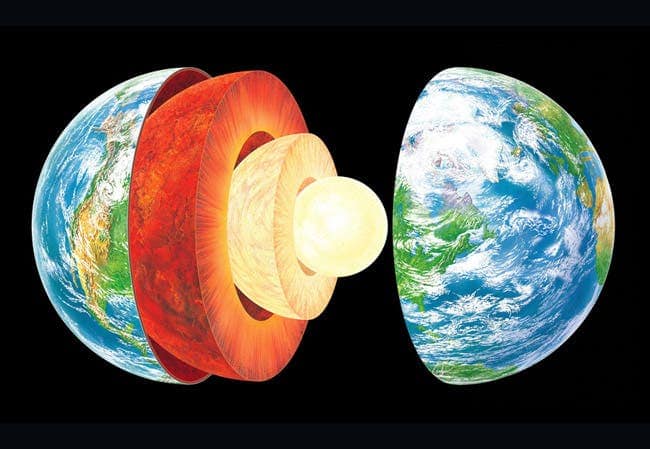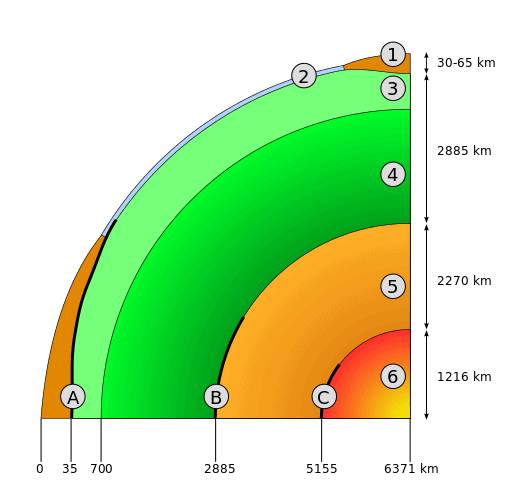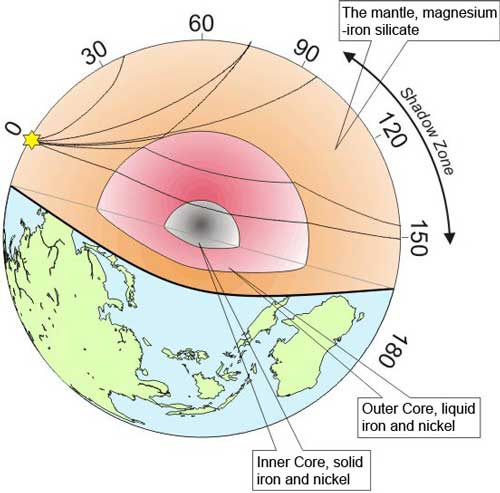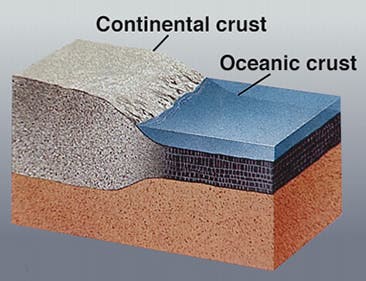The Earth can be divided into four main layers: the solid crust on the outside, the mantle, the outer core, and the inner core. Out of them, the crust is the thinnest layer of the Earth, amounting for less than 1% of our planet’s volume.
The Earth’s structure

Everything we see around us, the land and the oceans, the atmosphere, and all life on Earth, lies on the crust. It’s tempting to think that what we see on the crust is also representative of the deeper parts of the planet. But that’s not true at all.
The properties of the subsurface change with depth. At some point, these changes become so pronounced that the structure changes completely, and that’s when you get a new “layer” of the Earth (though you can’t exactly call the core a layer).
The Earth’s structure can be classified in two ways — based on mechanical properties and based on chemistry. Depending on which classification you follow, there can be small variations regarding where one layer ends and another begins. Here, we’re just going to discuss a basic classification, without going into too many details, focusing just on the essential aspects. The main focus here is to understand what the Earth’s crust represents, and why it is the thinnest layer.
- The crust ranges from 5–70 km (3–44 miles) in depth and is the outermost layer. The thinnest parts are oceanic crust, while the thicker parts are continental crust. Oceanic crust is not only thinner but also denser than continental crust. Most rocks at the Earth’s surface are relatively young (less than 100 million years old, compared to the Earth’s age, which is approximately 4.4 billion years), but since we found some much older rocks, we know that Earth had solid crust for at least 4.4 billion years.
- The mantle extends from where the crust ends to about 2,890 km, making it the thickest layer of Earth. The mantle is also composed of silicate rocks and it is technically solid, but in the long term, the mantle as a whole behaves as a viscous material — it flows. Think of it as behaving like thick honey or caramel, with the high temperatures causing the silicate material to melt and become sufficiently ductile that it can flow. The mantle is generally divided into the upper and the lower mantle.
- The core is typically divided into the outer core and the inner core . The outer core is regarded as viscous, though much less so than the mantle, while the inner core is solid. There is no direct evidence about what the core is made of, but based on model studies and what information we can gather from other bodies in the solar system, the inner core is thought to consist of an iron-nickel alloy with some other elements
The layers of the Earth are separated by something called discontinuities — boundaries that separate one from the other. These boundaries may not be strict lines, but rather transition zones.

The Earth’s crust
Our planet’s crust is on average about 40 km deep – which is much thinner than the mantle, the outer core, and the inner core — you can think of it like the peel of an apple. To scale, it would be much thinner. The crust here has been generated through igneous processes, which explains why the crust has many more incompatible elements than the mantle.
However, unlike the other layers of the Earth, the crust also interacts with the atmosphere and hydrosphere, meaning it is subjected to things like erosion and weathering, unlike the mantle, for instance.
At the bottom of the oceans and some seas, there is the oceanic crust. Oceanic crust is very thin (usually under 10 km), and is composed of dense, typically dark (called ‘mafic’) rocks like basalt and gabbro.
The continental crust is thicker than that – usually, it’s around 40 km deep but can go up to 70 km. The two types of crust are also sometimes called granitic (continental) and basaltic (oceanic).
The crust is not one single, uniform rigid layer but rather, it is broken into fifteen tectonic plates, all in relative movement from one another. This is called global tectonics.
The tectonic plates themselves are thicker than the crust alone, and also consist of the shallow mantle beneath the crust – this together is called the lithosphere (remember when we said the planet’s internal structure can be classified in two ways). The crust is where rocks interact with the hydrosphere and more importantly, the atmosphere. New rocks, minerals, and, materials are formed here.
Here’s the important part: all of the variety and phenomena that we can see with our own eyes take place in the crust. We haven’t dug all the way to the mantle. Everything, from mining ores to oil to forming mountains to thick deposits, faults, and whatever you ever heard about geologists observing directly takes place inside the crust (or at the very surface). The deepest we’ve ever drilled is just over 12 km, and we won’t be seeing the bottom of the crust with our own eyes for a very long time.
How we know
Okay, so there’s a crust, it’s thin, and there’s also a mantle and a core… but if we can’t go there, how do we know? That’s a very good question — but this is where science comes in.
We can observe some rocks that originated in the mantle at the surface (they’ve been pushed gradually by geological processes). We can also carry out experiments and simulations to mimic the conditions in the mantle and core, and we can also make observations on other celestial bodies in the solar system that can offer indications about our own planet.
But for the most part, we know all of this (and we know it with a very high degree of confidence) through indirect observation of earthquakes.

A century ago, people didn’t know the Earth had a crust. Some theorized it did, but there was very little proof. The first clues came from astronomic indications, but most of what we know today about the Earth’s structure comes from seismological observations. Seismic waves from large earthquakes pass throughout the Earth, and they carry with them information from the environments they pass through. Just like rays of light, seismic waves can reflect, refract, and diffract.
Because the speed of the seismic waves depends on density, we can use the travel time of seismic waves to map changes in density with depth. Also, because some waves only propagate through solid environments, we know that some environments (like the outer core) are viscous – because the waves don’t propagate through them.
In 1909, the brilliant seismologist Andrija Mohorovicic found that about 50 kilometers deep in the Earth there was a sudden change in seismic velocity – and knew that it must be a very significant discontinuity. He also observed that seismic waves reflect and refract at that depth, which confirmed his ideas. That discontinuity, named today the Mohorovicic discontinuity (or simply “Moho”) is regarded today as the limit between the crust and the mantle.
Ultimately, the fact that we understand the layers of the Earth so well without actually seeing them directly is a testament to how much science has progressed. There’s still much we’ve yet to learn, but science isn’t staying still: every year, we’re learning something new about the planet we live on,







